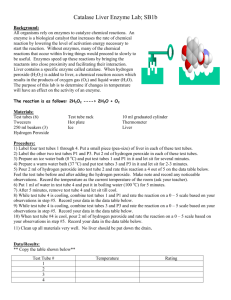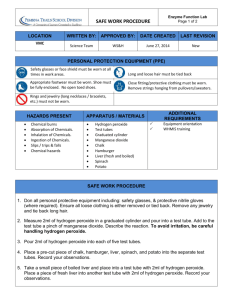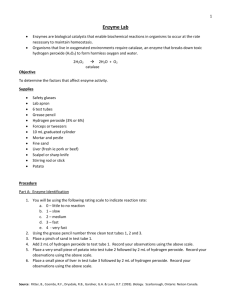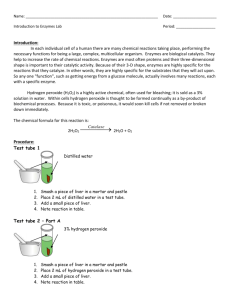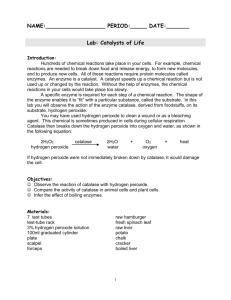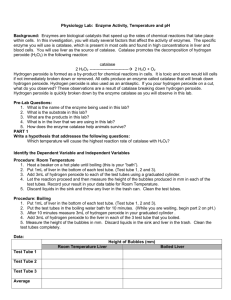Liver Enzyme Lab
advertisement
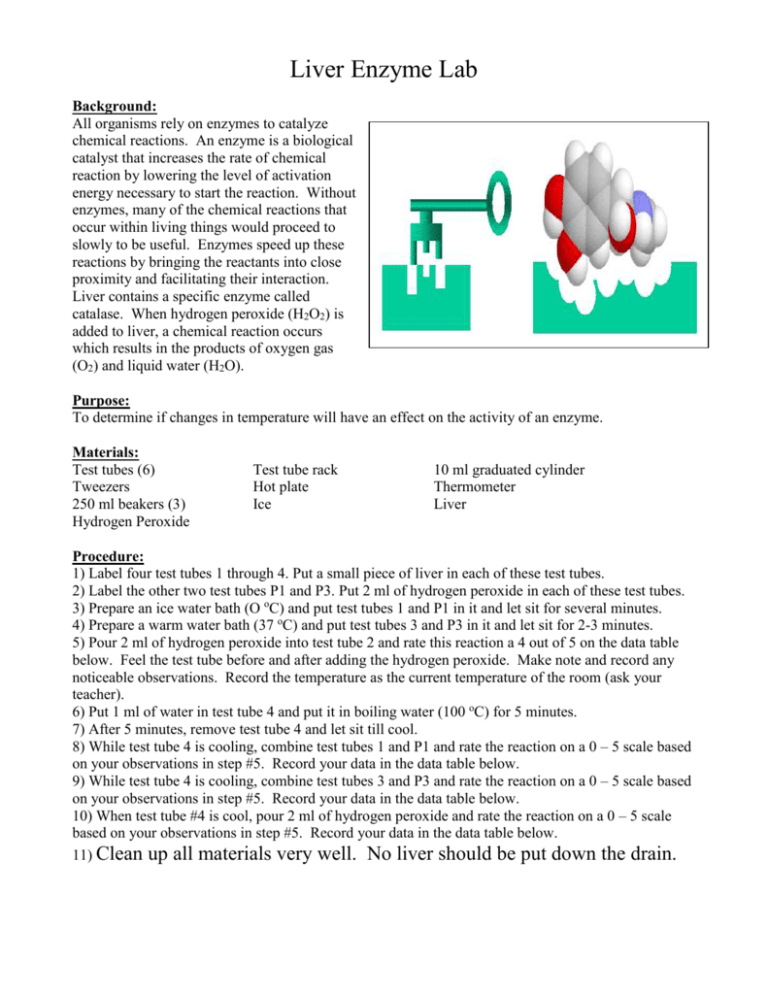
Liver Enzyme Lab Background: All organisms rely on enzymes to catalyze chemical reactions. An enzyme is a biological catalyst that increases the rate of chemical reaction by lowering the level of activation energy necessary to start the reaction. Without enzymes, many of the chemical reactions that occur within living things would proceed to slowly to be useful. Enzymes speed up these reactions by bringing the reactants into close proximity and facilitating their interaction. Liver contains a specific enzyme called catalase. When hydrogen peroxide (H2O2) is added to liver, a chemical reaction occurs which results in the products of oxygen gas (O2) and liquid water (H2O). Purpose: To determine if changes in temperature will have an effect on the activity of an enzyme. Materials: Test tubes (6) Tweezers 250 ml beakers (3) Hydrogen Peroxide Test tube rack Hot plate Ice 10 ml graduated cylinder Thermometer Liver Procedure: 1) Label four test tubes 1 through 4. Put a small piece of liver in each of these test tubes. 2) Label the other two test tubes P1 and P3. Put 2 ml of hydrogen peroxide in each of these test tubes. 3) Prepare an ice water bath (O oC) and put test tubes 1 and P1 in it and let sit for several minutes. 4) Prepare a warm water bath (37 oC) and put test tubes 3 and P3 in it and let sit for 2-3 minutes. 5) Pour 2 ml of hydrogen peroxide into test tube 2 and rate this reaction a 4 out of 5 on the data table below. Feel the test tube before and after adding the hydrogen peroxide. Make note and record any noticeable observations. Record the temperature as the current temperature of the room (ask your teacher). 6) Put 1 ml of water in test tube 4 and put it in boiling water (100 oC) for 5 minutes. 7) After 5 minutes, remove test tube 4 and let sit till cool. 8) While test tube 4 is cooling, combine test tubes 1 and P1 and rate the reaction on a 0 – 5 scale based on your observations in step #5. Record your data in the data table below. 9) While test tube 4 is cooling, combine test tubes 3 and P3 and rate the reaction on a 0 – 5 scale based on your observations in step #5. Record your data in the data table below. 10) When test tube #4 is cool, pour 2 ml of hydrogen peroxide and rate the reaction on a 0 – 5 scale based on your observations in step #5. Record your data in the data table below. 11) Clean up all materials very well. No liver should be put down the drain. Data/Results: ** Copy the table shown below** Test Tube # 1 2 3 4 Temperature Rating Construct a line graph based on the data above. Label the horizontal axis temperature and the vertical axis rating. ** Do not forget…tables and graphs need appropriate titles and labels to each part. Discussion: 1) What are enzymes? What are their roles in chemical reactions? 2) Describe what happened to test tube 2 when hydrogen peroxide was added to the liver. What gas was produced? What liquid was left behind? 3) Was the reaction in test tube 2 exothermic (exergonic) or endothermic (endergonic)? Explain how you knew. 4) What factors could have influenced the rating of the chemical reaction between the liver and the hydrogen peroxide? Give two factors. Explain each. 5) What effect does temperature have on the activity level of an enzyme? (Hint: Look at what happened in test tubes 1 and 4).
